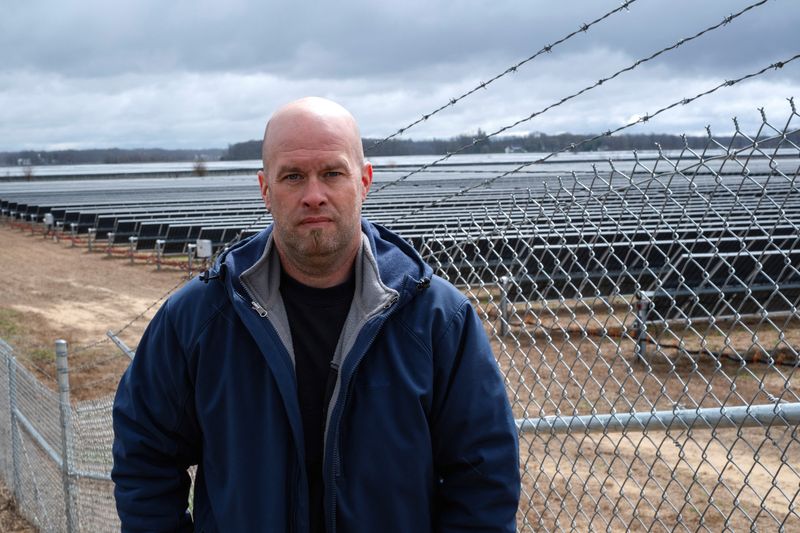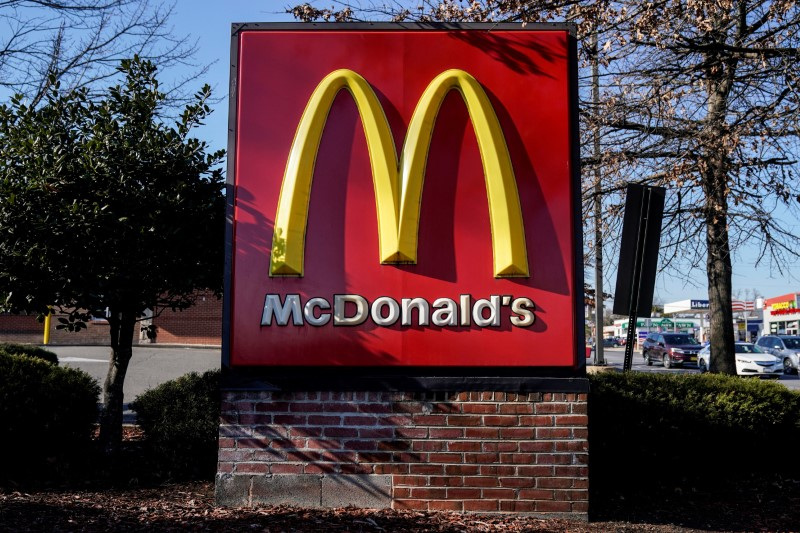Stock Markets
As solar capacity grows, some of America’s most productive farmland is at risk

By P.J. Huffstutter and Christopher Walljasper
JASPER COUNTY, INDIANA (Reuters) – Dave Duttlinger’s first thought when he saw a dense band of yellowish-brown dust smearing the sky above his Indiana farm was: I warned them this would happen.
About 445 acres of his fields near Wheatfield, Indiana, are covered in solar panels and related machinery – land that in April 2019 Duttlinger leased to Dunns Bridge Solar LLC, for one of the largest solar developments in the Midwest.
On that blustery spring afternoon in 2022, Duttlinger said, his phone rang with questions from frustrated neighbors: Why is dust from your farm inside my truck? Inside my house? Who should I call to clean it up?
According to Duttlinger’s solar lease, reviewed by Reuters, Dunns Bridge said it would use “commercially reasonable efforts to minimize any damage to and disturbance of growing crops and crop land caused by its construction activities” outside the project site and “not remove topsoil” from the property itself. Still, sub-contractors graded Duttlinger’s fields to assist the building of roads and installation of posts and panels, he said, despite his warnings that it could make the land more vulnerable to erosion.
Crews reshaped the landscape, spreading fine sand across large stretches of rich topsoil, Duttlinger said. When Reuters visited his farm last year and this spring, much of the land beneath the panels was covered in yellow-brown sand, where no plants grew.
“I’ll never be able to grow anything on that field again,” the farmer said. About one-third of his approximately 1,200-acre farm – where his family grows corn, soybeans and alfalfa for cattle – has been leased.
remove ads
.
The Dunns Bridge Solar project is a subsidiary of NextEra Energy (NYSE:) Resources LLC, the world’s largest generator of renewable energy from wind and solar. Duttlinger said when he approached NextEra about the damage to his land, the company said it would review any remedial work needed at the end of its contract in 2073, as per the terms of the agreement.
NextEra declined to comment on the matter or on what future commitments it made to Duttlinger, and Reuters could not independently confirm them. Project developer Orion Renewable Energy Group (NASDAQ:) LLC directed questions to NextEra.
The solar industry is pushing into the U.S. Midwest, drawn by cheaper land rents, access to electric transmission, and a wealth of federal and state incentives. The region also has what solar needs: wide-open fields.
A renewable energy boom risks damaging some of America’s richest soils in key farming states like Indiana, according to a Reuters analysis of federal, state and local data; hundreds of pages of court records; and interviews with more than 100 energy and soil scientists, agricultural economists, farmers and farmland owners, and local, state and federal lawmakers.
Some of Duttlinger’s farm, including parts now covered in solar panels, is on land classified by the U.S. Department of Agriculture (USDA) as the most productive for growing crops, according to a Reuters analysis.
For landowners like Duttlinger, the promise of profits is appealing. Solar leases in Indiana and surrounding states can offer $900 to $1,500 an acre per year in land rents, with annual rate increases, according to a Reuters review of solar leases and interviews with four solar project developers. In comparison, farmland rent in top corn and soybean producers Indiana, Illinois and Iowa averaged about $251 per acre in 2023, USDA data shows.
remove ads
.
Farmland Partners Inc, a publicly traded farmland real estate investment trust (REIT) has leased about 9,000 acres nationwide to solar firms. Much of that ground is highly productive, said Executive Chairman Paul Pittman.
“Do I think it’s the best use of that land? Probably not. But our investors would kill us if we didn’t pursue this,” he said.
Some renewable energy developers said not all leases become solar projects. Some are designing their sites to make it possible to grow crops between panels, while others, like Doral Renewables LLC, said they use livestock to graze around the panels as part of their land management. Developers also argue that in the Midwest, where more than one-third of the U.S. corn crop is used for ethanol production, solar energy is key for powering future electric vehicles.
Some agricultural economists and agronomists counter that taking even small amounts of the best cropland out of production for solar development and damaging valuable topsoil impacts future crop potential in the United States.
Common solar farm construction practices, including clearing and grading large sections of land, also can lead to significant erosion and major runoff of sediment into waterways without proper remediation, according to the U.S. Environmental Protection Agency and the Justice Department.
Solar development comes amid increasing competition for land: In 2023, there were 76.2 million – or nearly 8% – fewer acres in farms than in 1997, USDA data shows, as farmland is converted for residential, commercial and industrial use.
In response to Reuters’ findings, USDA said that urban sprawl and development are currently bigger contributors to farmland loss than solar, citing reports from the Department of Energy and agency-funded research.
remove ads
.
BUILDING ON PRIME CROPLAND
No one knows how much cropland nationwide is currently under solar panels or leased for possible future development. Land deals are typically private transactions. Scientists at the United States Geological Survey and the U.S. Department of Energy’s Lawrence Berkeley National Laboratory have been compiling a database of existing solar facilities across the country. While that project is incomplete and ongoing, Reuters found that around 0.02% of all cropland in the continental U.S. intersected in some way with large-scale, ground-based solar panel sites they had identified as of 2021.
The total power capacity of the solar operations tracked in the data set represents over 60 gigawatts of electric power capacity. In the following two years, solar capacity has nearly tripled, according to a Dec. 2023 report from the Solar Energy Industries Association (SEIA) and Wood Mackenzie.
To better understand future land-use patterns, Reuters analyzed federal government data to identify cropland that USDA classified as prime, unique, or of local or statewide importance. Reuters also reviewed more than 2,000 pages of solar-related documents filed at local county recorders’ offices in a small sample of four Midwestern counties – Pulaski, Starke and Jasper counties in Indiana, and Columbia County in Wisconsin.
The counties, representing an area of land slightly bigger than the state of Delaware, are where some of the nation’s largest projects are being developed or built. The sample is not necessarily representative of the broader United States but gives an idea of the potential impact of solar projects in farm-heavy counties.
remove ads
.
Reuters found the percentage of these counties’ most productive cropland secured by solar and energy companies as of end of 2022 was as follows: 12% in Pulaski, 9% in Starke, 4% in Jasper and 5% in Columbia.
Jerry Hatfield, former director of USDA Agricultural Research Service’s National Laboratory for Agriculture and the Environment, said Reuters’ findings in the four counties are “concerning.”
“It’s not the number of acres converting to solar,” he said. “It’s the quality of the land coming out of production, and what that means for local economies, state economies and the country’s future abilities for crop production.”
More than a dozen agronomists, as well as renewable energy researchers and other experts consulted by Reuters, said the approach to measuring solar’s impact was fair. The news agency also shared its findings with six solar developers and energy firms working in these counties. Three said Reuters’ sample size was too small, and the range of findings too wide, to be a fair portrayal of industry siting and construction practices.
By 2050, to meet the Biden Administration’s decarbonization targets, the U.S. will need up to 1,570 gigawatts of electric energy capacity from solar.
While the land needed for ground-based solar development to achieve this goal won’t be even by state, it is not expected to exceed 5% of any state’s land area, except the smallest state of Rhode Island, where it could reach 6.5%, by 2050, according to the Energy Department’s Solar Futures Study, published in 2021.
Researchers at American Farmland (NYSE:) Trust, a non-profit farmland protection organization which champions what it calls Smart Solar, forecast last year that 83% of new solar energy development in the U.S. will be on farm and ranchland, unless current government policies changed. Nearly half would be on the nation’s best land for producing food, fiber, and other crops, they warned.
remove ads
.
FUEL DEBATE
Five renewable developers and solar energy firms interviewed by Reuters counter that the industry’s use of farmland is too small to impact domestic food production overall and should be balanced with the need to decarbonize the U.S. energy market in the face of climate change.
Doral Renewables, the developer behind the $1.5 billion Mammoth Solar project in Pulaski and Starke counties, does not consider corn or soybean yields in its siting decisions.
Instead, the company looks at the land’s topography, zoning and closeness to an electrical grid or substation – and tries to avoid wooded areas, ditches and environmentally sensitive areas, said Nick Cohen, Doral’s president and CEO.
Shifting corn acres for solar? “I don’t see it as replacing something that is vital to our society,” Cohen said. Solar can make farmland “more productive from an economic perspective,” he added.
Indiana farmer Norm Welker says he got a better deal leasing 60% of his farmland to Mammoth than he would have growing corn, with prices dipping to three-year lows this year.
“We’ve got mounds of corn, we’re below the cost of production, and right now, if you’re renting land to grow corn – you’re losing money,” Welker said. “This way, my economic circumstances are very good.”
Stock Markets
Revance Therapeutics stock price target cut on first quarter performance

On Friday, Piper Sandler adjusted its outlook on Revance Therapeutics (NASDAQ:), reducing the stock price target to $11 from the previous $20, while maintaining an Overweight rating on the stock. The adjustment comes after Revance reported first-quarter financial results, revealing an adjusted net loss per share of $0.43 and revenue of $51.9 million.
These figures stood in contrast to the Street’s expectations, which anticipated a slightly higher loss per share of $0.46 and revenue of $56.4 million.
Despite the lowered stock price target, the firm’s analysts believe Revance is on track to meet its 2024 net sales goal of at least $280 million, a figure that is slightly below the consensus estimate of approximately $292 million. The company’s management has indicated that more than half of these sales are projected to come from its RHA product line, according to commentary from Revance.
Revance’s Daxxify, a product used in facial aesthetics, is showing promising performance with sales annualizing to nearly $90 million after five full quarters in the market. Moreover, the RHA franchise is annualizing at about $120 million in sales, approximately three years after its launch.
The first quarter is typically the slowest in the facial aesthetics industry, yet these figures suggest potential for the company to reach its stated top-line goals for the year.
The firm’s analysis suggests that Revance Therapeutics has a “fighting chance” of achieving its 2024 revenue targets. The analysts forecast that the company could reach a break-even point sometime in 2025. The revised price target of $11, down from $20, reflects more conservative estimates for Daxxify and RHA sales beyond the year 2024.
remove ads
.
InvestingPro Insights
Piper Sandler’s recent price target adjustment for Revance Therapeutics (NASDAQ:RVNC) to $11 coincides with some critical financial metrics and market performance data. According to InvestingPro Data, Revance’s market capitalization stands at $447.08 million, with a significant revenue growth of 76.55% in the last twelve months as of Q4 2023. This growth is notable, especially considering the company’s revenue of $234.04 million in the same period.
Despite this revenue upswing, Revance’s profitability challenges are evident. The company’s P/E ratio is negative, at -1.85, and it has not been profitable over the last twelve months. This aligns with the InvestingPro Tip that analysts do not anticipate the company will be profitable this year. Moreover, the stock price has experienced a considerable decline over the last year, with a 1 Year Price Total Return of -88.15%.
Still, there is a silver lining. Revance’s liquid assets exceed its short-term obligations, suggesting a degree of financial stability. Moreover, the company has seen a significant return over the last week, with a 1 Week Price Total Return of 8.61%. This could indicate investor optimism in the short term, potentially reflecting confidence in the company’s strategic direction or product offerings.
For those interested in a deeper analysis, InvestingPro offers additional insights on Revance Therapeutics. There are more InvestingPro Tips available, which could further guide investment decisions. To explore these tips and gain more detailed financial insights, consider using the coupon code PRONEWS24 to get an additional 10% off a yearly or biyearly Pro and Pro+ subscription.
remove ads
.
This article was generated with the support of AI and reviewed by an editor. For more information see our T&C.
Stock Markets
US bill to restrict WuXi AppTec, Chinese biotechs revised to give more time to cut ties

By Karen Freifeld
(Reuters) -A new version of a congressional bill that would restrict U.S. business with certain Chinese biotechnology companies including WuXi AppTec and BGI would give U.S. companies until 2032 to end work with the firms, extending the amount of time to find new partners.
The latest Biosecure Act also adds WuXi Biologics (HK:) to a list of biotech companies of concern, according to a copy seen by Reuters. The other companies on the list are BGI , MGI, Complete Genomics and WuXi AppTec .
The revised bill will be introduced on Friday and a U.S. House of Representatives committee is expected to decide next week whether to move the bill forward, according to a House Committee on Oversight and Accountability spokesperson.
The committee markup, expected Wednesday, is a procedural step in the process to the bill’s possibly becoming law. A similar Senate bill was approved by a committee there in March.
The bills are designed to keep Americans’ personal health and genetic information from foreign adversaries. News of the proposed legislation has driven WuXi AppTec and WuXi Biologics shares down this year.
A spokesperson for WuXi Biologics said they had not yet seen the revised bill and could not comment. WuXi AppTec and MGI did not immediately respond to requests for comment.
Complete Genomics said it is “encouraged that policymakers understand the detrimental impacts to the U.S. biotech supply chain – and how the legislation would jeopardize the drug supply for millions of American patients.” It said it does not have access to personal DNA data and should be removed from the legislation.
remove ads
.
The latest bill “highlights a key vulnerability in our global supply chain and importantly provides a reasonable timeframe for companies to decouple their reliance on China-based biomanufacturing,” John Crowley, president of BIO, an industry association, said in a statement.
The association sent the results of a survey of member companies to congressional contacts on Wednesday. Of the 124 biopharmaceutical companies and biotechnology companies that responded, 79 percent had at least one contract or product agreement with a China-based or owned manufacturer.
The “vast majority” of business described in the survey is assumed to be with WuXi Biologics and WuXi AppTec, Crowley said in an interview.
Companies estimated it would take up to eight years to switch manufacturing partners, the survey found.
WuXi AppTec has said it fully complies with the strict reporting, oversight and inspection requirements of its customers and U.S. federal agencies.
BGI Group said, as it has in the past, that it supports protecting Americans’ personal data and did not have access to the data. It said the bill would drive BGI out of the U.S. and limit competition and that a U.S. company had been lobbying on it.
“This legislation will give a single company total control of the U.S. market, resulting inevitably in higher prices and reduced choice,” Complete Genomics added.
Stock Markets
McDonald’s considering $5 meal deal launch to draw diners, source says

(Reuters) -McDonald’s U.S. franchises are considering launching a $5 meal deal, a source familiar with the matter said on Friday, as the fast-food chain looks to draw more inflation-hit customers to its restaurants.
Global restaurant chains such as McDonald’s (NYSE:) and Starbucks (NASDAQ:) have seen lower-income customers opting to eat more meals at home amid a cost-of-living crisis, forcing the companies to offer steeper promotions to attract them to their outlets.
McDonald’s, which has a higher exposure to the lower-income cohort, saw its global sales growth slowing for the fourth straight quarter.
“I think it’s important to recognize that all income cohorts are seeking value,” CEO Chris Kempczinski said on a post-earnings call last month.
Bloomberg News first reported about McDonald’s plans.
McDonald’s shares were up about 2% at $272.80 following the news.

 Forex2 years ago
Forex2 years agoForex Today: the dollar is gaining strength amid gloomy sentiment at the start of the Fed’s week

 Forex2 years ago
Forex2 years agoHow is the Australian dollar doing today?

 Forex1 year ago
Forex1 year agoUnbiased review of Pocket Option broker

 Forex2 years ago
Forex2 years agoDollar to pound sterling exchange rate today: Pound plummeted to its lowest since 1985

 Cryptocurrency2 years ago
Cryptocurrency2 years agoWhat happened in the crypto market – current events today

 World2 years ago
World2 years agoWhy are modern video games an art form?

 Stock Markets2 years ago
Stock Markets2 years agoMorgan Stanley: bear market rally to continue

 Economy2 years ago
Economy2 years agoCrude oil tankers double in price due to EU anti-Russian sanctions

































